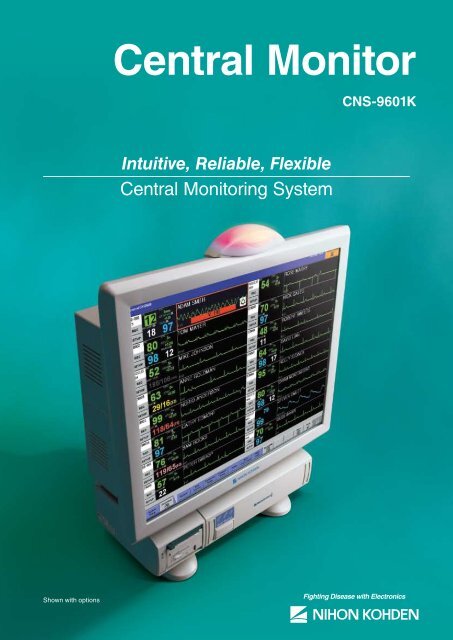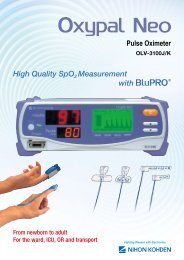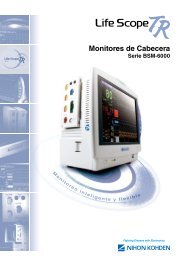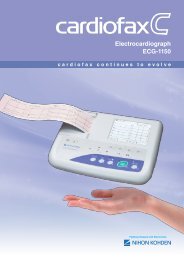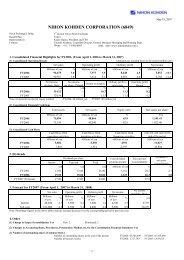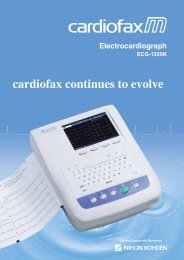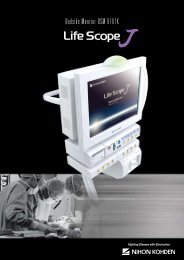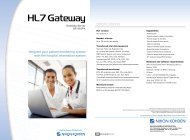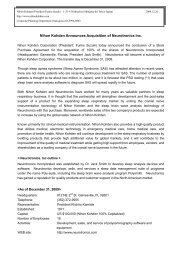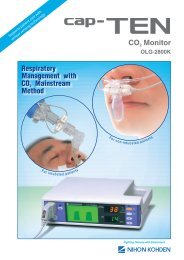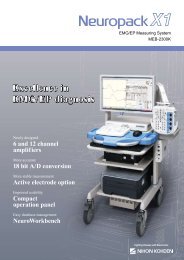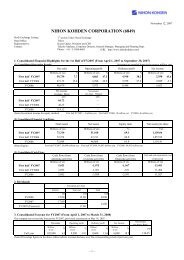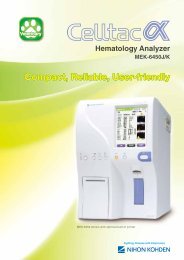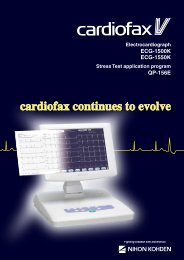Central Monitor - Nihon Kohden
Central Monitor - Nihon Kohden
Central Monitor - Nihon Kohden
You also want an ePaper? Increase the reach of your titles
YUMPU automatically turns print PDFs into web optimized ePapers that Google loves.
<strong>Central</strong> <strong>Monitor</strong><br />
CNS-9601K<br />
Intuitive, Reliable, Flexible<br />
<strong>Central</strong> <strong>Monitor</strong>ing System<br />
Shown with options
Common complaints about<br />
typical central monitoring systems<br />
Complicated operation<br />
Too many false alarms so staff can’t rely on them<br />
Stored data can’t be reviewed efficiently<br />
1
CNS-9601K<br />
Shown with options<br />
<strong>Nihon</strong> <strong>Kohden</strong><br />
provides the solution<br />
Intuitive operation<br />
Easy and fast. Just touch or click the parameter you want to change.<br />
Reliable alarms<br />
You can reduce false alarms by reviewing alarm and measurement<br />
conditions on the alarm review screen.<br />
Flexible review<br />
The nine different review screens are time synchronized with each other so<br />
you can easily review the same patient event in different ways.<br />
2
Intuitive operation<br />
The typical central monitor is complicated to operate. Operations need many steps to change<br />
settings, so if you change a setting, it takes a lot of time.<br />
Our CNS series is designed so it can be used without the operator’s manual. With the<br />
intuitive operation, most functions can be done in just 3 steps so busy staff can spend<br />
their time on patient care.<br />
1. Touch or click the data area for the patient<br />
2. Touch or click the parameter<br />
3. Touch or click a new setting<br />
Touch screen operation<br />
With a VL-974P 19-inch color<br />
LCD display, you can operate<br />
the monitor by touch screen. You<br />
can also use a local purchase<br />
display and operate the monitor<br />
by keyboard and mouse.<br />
The bottom of the screen has 7 function keys.<br />
Assign your most frequently used screens to the function keys for instant access.<br />
3
Easy alarm setup<br />
Multi patient limits screen<br />
The multi patient limits screen helps you set alarms more efficiently. Alarm levels for up to 8 patients are<br />
shown on one screen so you can check and change alarm settings compared to other patients.<br />
Flexible screen layouts for any number of patients<br />
16 patients<br />
12 patients<br />
1 wave<br />
8 patients<br />
2 waves<br />
6 patients 4 patients<br />
1 wave<br />
2 waves<br />
3 waves<br />
3 waves<br />
4 waves<br />
6 waves<br />
4
Reliable alarms<br />
Typical central monitors cause too many false alarms so staff can’t rely on them.<br />
Many false alarms are caused by technical alarms and unsuitable alarm settings.<br />
In order to improve this, a new window was added to CNS-9601K: Multi Patient Alarm<br />
Event window. This can help reduce false alarms and provide high quality patient care.<br />
Alarm type hide and display button<br />
In the multi patient alarm event window, you can hide and display the alarm depending on the type of alarm.<br />
• Limit alarm<br />
Vital signs alarms indicate the condition of each parameter.<br />
• Arrhythmia alarm<br />
You can check the frequency of arrhythmias on one screen.<br />
This can show the effect of arrhythmia drugs.<br />
• Technical alarms<br />
This can help manage the electrode replacement cycle.<br />
Technical status signal<br />
You can display the frequency of technical alarms<br />
in the last hour, indicated by specified color. This<br />
shows at a glance the measuring conditions such<br />
as electrode attachment or noise.<br />
Green (Good):<br />
less than 10 alarms in one hour<br />
Yellow (Not Bad):<br />
10 to 29 alarms in one hour<br />
Red (Bad):<br />
over 30 alarms in one hour<br />
5
Alarm related features<br />
Optional alarm indicator<br />
The alarm indicator on the top of the display can<br />
be clearly seen at a distance. The blinking or<br />
steady lighting condition and color shows alarm<br />
information. The blinking alarm indicator is also<br />
synchronized with heart rate, blood pressure or<br />
SpO 2 of a selected patient.<br />
Color coded alarm level<br />
Alarms are indicated by a blinking frame and highlighted message. Red<br />
shows CRISIS alarms and orange shows WARNING alarms.<br />
Minimum alarm volume<br />
To prevent missed alarms, the administrator can<br />
set a minimum alarm volume.<br />
Settings security<br />
For security, some settings are password<br />
protected so they can be controlled by an<br />
administrator.<br />
6
SYNCHRO<br />
Flexible review<br />
Synchronized review data<br />
Typical central monitors cannot review the stored data efficiently. It takes many steps to find and display the data, and<br />
the data aren’t linked to each other.<br />
CNS-9601K lets you review synchronized data in different ways. All 9 review screens are timesynchronized<br />
so that when you find an alarm or arrhythmia episode, you can see the same event on<br />
other review screens as full disclosure, trend or numeric data to check details. This is an easy onestep<br />
operation. CNS-9601K lets you review data accurately and quickly.<br />
9 ways to review<br />
1) Trend graphs<br />
Trend graphs of 4 parameters and 2 events of the last 72 hours<br />
can be displayed.<br />
2) Tabular trends<br />
Numeric data of measured parameters for<br />
the latest 72 hours can be displayed in a<br />
table.<br />
3) Hemodynamics data<br />
Up to 256 hemodynamics<br />
measurements can be displayed<br />
in 8 rows per screen.<br />
TIME<br />
4) Arrhythmia recall<br />
Up to 768 eight-second arrhythmia<br />
episodes for each patient can be stored<br />
and reviewed.<br />
5) ST recall<br />
ST recall files are created at specified intervals. Up to<br />
4320 files can be saved. 7 files can be displayed at the<br />
same time.<br />
7
9) Alarm events window<br />
72-hour alarm lists for 8 persons can be displayed at the<br />
same time. There are 3 types of alarm displays: vital sign<br />
alarms, arrhythmia alarms, and technical alarms.<br />
8) Alarm history<br />
The latest 1000 files can be saved for<br />
each bed. The alarm history window<br />
displays the file list with report creation<br />
time, alarm levels, parameters,<br />
descriptions, and other information.<br />
NIZED<br />
7) 12-lead ECG analysis<br />
12-lead ECG analysis waveform, average<br />
waveform, comparison waveforms, and<br />
analysis reports from the bedside monitor<br />
can be displayed.<br />
6) Full disclosure ECG<br />
Six 72-hour full disclosure waveforms for each patient can be<br />
stored and reviewed with an optional program kit.<br />
8
Flexible configuration<br />
Optional multiple patient receiver unit receives signals from transmitters. One receiver unit is for up to 8<br />
transmitters.<br />
Transmitters<br />
CNS-9601K<br />
BSM-6000 BSM-5100 BSM-4100 BSM-2300 BSM-9101K<br />
Wireless<br />
16 patients with two<br />
receiver units<br />
Shown with options<br />
Mixed<br />
Hardwired<br />
Wireless (8 patients)<br />
Hardwired (8 patients)<br />
16 patients<br />
ec1 arrhythmia analysis<br />
3000<br />
Number of false alarms<br />
<strong>Central</strong> monitor alarms begin with the<br />
connected bedside monitors. <strong>Nihon</strong> <strong>Kohden</strong>’s<br />
2500<br />
2000<br />
1500<br />
1000<br />
V. Rhythm<br />
Tachy<br />
VPC Run<br />
VT<br />
Ext. Tachy<br />
VF<br />
ec1 arrhythmia analysis algorithm can reduce<br />
80% of false alarms. ec1 is included in Life<br />
Scope i/L/TR/J and all newer bedside monitors<br />
500<br />
0<br />
Without ec1<br />
With ec1<br />
9
Life Scope Network<br />
Hospital Network<br />
(HIS/CIS)<br />
Dr’s PC<br />
OR<br />
HL7 Gateway<br />
ICU<br />
NetKonnect<br />
Server<br />
CCU<br />
Firewall<br />
NICU<br />
General ward<br />
Internet<br />
General ward<br />
Web browser<br />
NetKonnect<br />
Transmitters<br />
With optional NetKonnect, you can review real-time patient data anytime and anywhere from your PC with<br />
a web browser.<br />
HL7 Gateway<br />
An HL7 gateway connects the LS-NET monitor network to the HIS (Hospital Information System). With the<br />
HL7 gateway, vital sign data in the bedside monitor can be transferred using HL7 protocol.<br />
Major Options<br />
For full list of options and consumables, see the technical data separately available.<br />
Display unit<br />
VL-974P<br />
(Touch screen operation)<br />
Alarm indicator<br />
YL-960P<br />
J frame<br />
DM-960P<br />
Receiver unit<br />
RU-960P<br />
Receiver unit<br />
ORG-9100K<br />
Recorder unit<br />
WS-960P<br />
16-patient expansion program kit<br />
QP-962P<br />
Full disclosure filing program kit<br />
QP-963P<br />
12-lead ECG interpretation kit<br />
QP-964P<br />
10
This brochure may be revised or replaced by <strong>Nihon</strong> <strong>Kohden</strong> at any time without notice.<br />
6213 CAT.No.58-024A ’09.11. CLB. E.<br />
Printed in Japan on FSC certified paper


